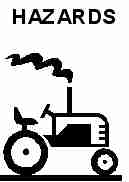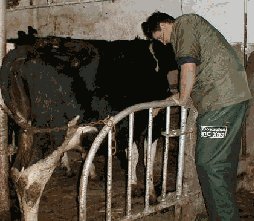Hazards - Physical Chemical & Biological

Physical hazards include all those things that can break, bump, thump, hit, or cut you - that may be something to trip over, fall on you, or hard to lift. The hazard may be a one off or if repetitive may cause damage over a period of time - such as repetitive strain injury.
Noise accounts for deafness among a quarter of farm and holding workers. You may feel temporary deafness at the end of your working day, and this is a signal that if you continue to be exposed at these levels you may suffer permanent deafness. Such hearing damage is irreversible However, there is more to ear damage than hearing loss,including an annoying ringing in the ears called tinnitus. For more (pdf).
 The most common chemical hazards on farms are pesticides, but there are other such as fertilisers. The most likely hazard from pesticides is effects on the nervous system. Many organophosphates and carbamates cause nerves to fire more than they should. This results in headaches, stomach aches, or twitching hands. Pesticides can only be used if they have been approved for use (ACP). As part of the approval, conditions are laid down by law as to how they can be used and this is passed on to users through the label. The most dangerous time is when mixing pesticides prior to spraying. Toxicity of Pesticides
The most common chemical hazards on farms are pesticides, but there are other such as fertilisers. The most likely hazard from pesticides is effects on the nervous system. Many organophosphates and carbamates cause nerves to fire more than they should. This results in headaches, stomach aches, or twitching hands. Pesticides can only be used if they have been approved for use (ACP). As part of the approval, conditions are laid down by law as to how they can be used and this is passed on to users through the label. The most dangerous time is when mixing pesticides prior to spraying. Toxicity of Pesticides
 Zoonoses are bacteria and other living organisms that can infect people. By its very nature you are a particular risk on farms and small holdings.
Zoonoses are bacteria and other living organisms that can infect people. By its very nature you are a particular risk on farms and small holdings.
Common zoonoses include:
Escherichia coli (E.coli 0157) can be easily picked up from animals causing diarrhoea,
Leptosirosis (Weil's disease, and cattle associated Leptosporsis) both contracted from urine - rats or cattle,
Cryptospordiosis causes abdominal pain from infected dung,
Bovine TB infects people through inhalation from cattle ,
Streptococcus suis (S suis),
Orf is skin ulcers caused by a virus carried by sheep & goats,
Salmonella causes diarrhoea, Ovine chlamydiosis causes abortion from handling aftewrbirth or soiled work clothes
Ringworm fungus causing crusty lesions on skin,
Sittacosis causes 'flu-like illness from poultry,
Q fever is a disease causing chill and headaches from sheep and cattle,
 Weil's Disease and other Zoonoses
Weil's Disease and other Zoonoses
some of which can also affect humans. These diseases
are known as zoonoses, and if you work with animals
your health may be at risk from them.
Licensed under the Creative Commons Attribution 2.5 License
LANTRA Awards: Controlling Risks in Agriculture Level 3